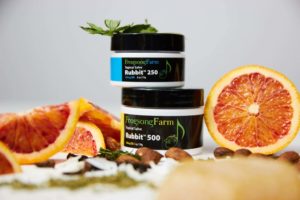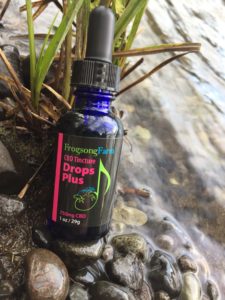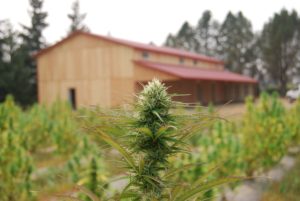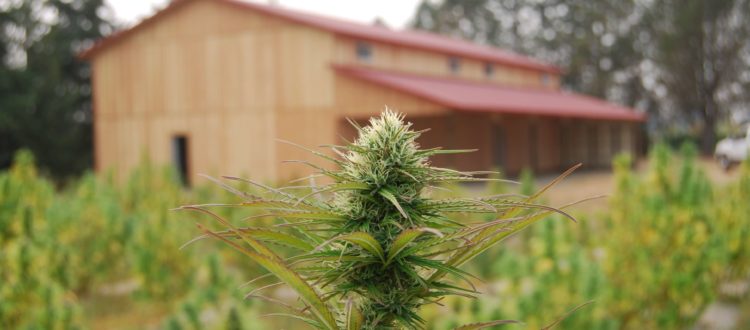Vendor Feature: The ABCs of CBD from Frog Song Farm
By Becca Recker, Frog Song Farm
Find Frog Song Farm at the PSU and Shemanski Park markets

Photo courtesy of Frog Song Farm
“That stuff doesn’t work,” comes the all-too-common complaint from people who’ve tried cannabidiol, aka CBD, the non-psychoactive compound found in certain strains of cannabis.
CBD does work: research suggests the compound can relieve pain and inflammation, reduce anxiety, and even fight cancer, and that’s why sales of CBD-infused extracts, tinctures, topicals and edibles are booming. In an article published by Forbes, The Hemp Business Journal estimated that the CBD market will grow to a $2.1 Billion market in consumer sales by 2020 with $450 million of those sales coming from hemp-CBD based sources. That’s a 700% increase from 2016. But for many lesser-educated consumers, CBD is still poorly understood, often because it’s mixed with THC products and therefore hard to distinguish from garden variety cannabis.
Is CBD by itself a panacea, or an overhyped placebo? Many who have experimented with CBD have only done so with THC-rich strains of marijuana, adding to the confusion. Frogsong Farm, a sustainable hemp farm in Woodburn, Oregon, is one of a handful of cultivators focusing extensively on CBD-only products. We’d be happy to talk further if that’s of interest.
Here’s the how-to:
Heat It
In its raw plant form, cannabis contains acidic compounds called THCA and CBDA. These are the precursors to their more bioavailable counterparts, THC and CBD. In order for the body to fullyaccess these cannabinoids, they must be decarboxylated, or heated. This can be done through cooking, smoking, or vaporizing. Find out if the CBD supplement you’re using is “raw” or “active.” While some medical conditions may improve by using the raw plant form CBDA, most people reap greater benefit from active, bioavailable CBD. This is essential to understand, especially for folks wishing to experiment with homemade CBD products. Raw flower must be heated correctly for maximum effectiveness.

Photo courtesy of Frog Song Farm
Find Your Dosage
There is no established recommended daily allowance of CBD. There is also no known overdose level. CBD is only approved federally for use as a nutritional supplement. This leaves consumers unsure of how much to take. 10-40 mg per day is a starting point for the average consumer looking for wellness benefits like mental clarity, improved sleep, and reduced inflammation. For chronic sleep disorders, 40-160 mg are often used. On the other hand, epilepsy and schizophrenia treatment can range from 200-1,200 mg/day. Body weight, cannabinoid sensitivity, and desired results should all be considered. They key is to experiment.
Remove Variables
For those wanting to understand their body’s response to CBD, it’s best to isolate it from high (or even any) amounts of THC. The psychoactive effects of THC can make it difficult to distinguish CBD’s more subtle effects on mood, relaxation, and stress response. Research has shown a synergistic effect between CBD and THC, leading some consumers to avoid using nonpsychoactive CBD supplements altogether. However, it’s important to know that most CBD extracts still contain trace amounts of THC, which, while not enough to get you high, still complements the body’s response to CBD. Most medical marijuana experts recommend using whole-plant extracts, which contain a broad array of cannabinoids, terpenes, and phytochemicals working together in what’s known as the “Entourage Effect.” THC and CBD tend to reduce one another’s side effects, resulting in a more effective and pleasant experience overall. But the notion that CBD is ineffective without THC is incorrect.

Photo courtesy Frog Song Farm
Know What You’re Getting
The “Green Rush” has a dark side. Put plainly, there are scores of scammers hoping to cash in on the CBD buzz, especially in the online market. A 2017 study by Penn State found that nearly 70% of all cannabidiol products sold online were mislabeled. This has serious health implications, especially for buyers with health conditions requiring a certain dosage for management of symptoms. Only buy from companies that are willing to provide a certificate of analysis (COA) from third party lab testing. Be sure that the milligrams of CBD per dose, and per container, is clearly labeled and easy to understand.
Reliable dispensaries and other retailers (like grocery co-ops and wellness centers) generally have a strong vetting process, so buying CBD from a brick & mortar establishment is a safer bet than buying online.
Consider Delivery Method
There are many ways to consume CBD, and the ideal method will depend on an individual’s symptoms. Topical products are best for localized pain management, as in arthritis, nerve pain, muscle tension and athletic injuries. Topical CBD does not enter the bloodstream. Instead, it penetrates into the skin and activates local endo-cannabinoid receptors responsible for mediating pain perception, inflammation, and body temperature. Applying a CBD salve or lotion can relieve pain and stiffness in as little as 5-10 minutes. Products can be reapplied as needed. Ingesting CBD also has its benefits. When CBD is ingested, be it as a tincture, a handful of gummies, or a bottle of kombucha, it enters the digestive system. Results set in more slowly (as anyone who has experimented with edibles can tell you.) Within 1-2 hours the CBD has entered the bloodstream and is activated throughout the body. For treatment of widespread pain and inflammation, as well as anxiety, depression, neurological disorders and sleep issues, internal use of CBD is recommended. This is the most researched method and considered most effective.Bottom line: Topical CBD is faster-acting and provides localized relief, while ingestible CBD is slower-acting and offers generalized relief.
Know What To Expect
Our culture is intimately familiar with stimulants and depressants of all types. We know how different substances affect our bodies and brains, and how and when to dose to get the desired effects. Even many herbal remedies have noticeable mind- and body-altering effects. CBD is different. Consider it a reset button. CBD works by promoting homeostasis throughout the brain and body. CBD is a balancer. Those with anxiety may feel calmer. Those with depression may feel lifted. Insomnia is replaced with rest. Mental fog turns into alertness and clarity. Or put another way: CBD removes barriers to wellbeing so the mind and body can find optimal function.
This is an important distinction. CBD will not cause a person to feel unnaturally relaxed, wired, or giddy. At a time when many of us swing from one high to another, CBD provides an opportunity to feel grounded, balanced, and unaltered.

